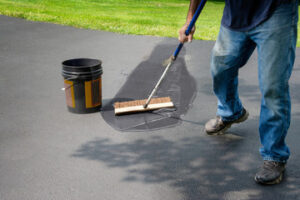Asphalt pavement deteriorates quickly when it is exposed to oil, gas and chemical substances. Sealcoating protects a paved surface from these destructive liquids and keeps it flexible to weather changes and vehicular pressure.
It also preserves that beautiful, brand-new black appearance. However, there are many types of sealcoating and not all are appropriate for every commercial property. Visit https://www.rochesternysealcoating.com/ to learn more.

Asphalt pavement is a combination of rock and stone aggregate held together with a binding material known as asphalt cement. Over time, sun and rain degrade the asphalt cement causing it to become brittle and crack. Sealcoating is an effective method of preventing the deterioration of asphalt and extending its life by creating a protective layer against oil, water, UV rays and other oxidizing substances.
Crack filling is one of the most important applications in the process of sealcoating. It is the process of filling in small cracks in your asphalt parking lot or driveway. This process prevents water from seeping through those cracks and freezing in the winter – thus damaging your asphalt surface. It also helps to restore the beauty of your asphalt and improves its curb appeal.
Before crack filling can be done, the crack needs to be cleaned out and prepped. Depending on your climate, you may need to perform crack sealing before crack filling. Typically, the best method is to use a motorized piece of equipment called a router which creates a channel for the crack to fill. This allows the crack sealer to flow more evenly – reducing the risk of future problems.
Once the crack is cleaned, it must be thoroughly dried before workers begin applying the seal coat. The drying time varies depending on your environment, but should be completed within 24 to 48 hours.
Crack Filling can be performed as a stand alone treatment for pavement that is in good condition or as part of a yearly maintenance and repair program. Performing this treatment will help to extend the life of your asphalt and save you money in the long run.
There are several different configurations of crack filling including reservoir, overband and a combination. Regardless of which configuration is chosen, it is important to use the right wand tip for the job. Using the wrong one can result in the crack filling materials tracking into buildings or other areas of the property which will require more expensive remediation.
Hot-applied crack filler can be used in cracks up to 3/4″ wide. For larger cracks, cold-applied crack sealers are available for application.
Preparation
Sealcoating is the process of applying a coating to asphalt surfaces such as driveways, parking lots, and roads. It is an effective way to prevent oxidation and damage caused by weather, salts, and oil spills. It also provides a protective layer that helps prolong the life of your pavement. In addition, it improves the appearance of your property by restoring sun-bleached areas and giving them a rich dark color. However, it is important to note that seal coating cannot repair cracked or damaged pavement and should only be used as a preventative measure.
Prior to the sealcoating process, your driveway or parking lot should be cleaned and free of any dirt, gravel, dust, and oil stains. You can do this by washing the area with a soap nozzle attached to your garden hose or power washer. Once the surface is clean, it is important to allow the paved surface to dry completely before sealcoating.
In addition, the area to be sealed must be closed off to all pedestrians and vehicles using barricades, cones, signs, and caution tape. It is also a good idea to reschedule or make alternative arrangements for deliveries that may be scheduled during this time.
The four major ingredients in a sealcoat mix are petroleum binder, water, silica sand, and polymer additives. The petroleum binder is responsible for binding the other ingredients together and providing asphalt surface protection. It also gives the sealcoat a deep black appearance and helps maintain its consistency and flexibility. The other ingredients in a sealcoat mix serve a variety of purposes, including drying the seal coat quickly, altering sand suspension, and increasing its resistance to salts and petrochemicals.
Refined coal tar is the most commonly used binder in a sealcoat mix. It is a thick black liquid that is a byproduct of the distillation of bituminous coal. However, it is important to note that refined coal tar has been linked to increased levels of polycyclic aromatic hydrocarbons in creek beds and streams. As a result, more and more local governments are banning its use.
Once the pavement is clean, workers will apply two applications of sealer using state-of-the-art spray application equipment. During the process, any sealer that gets on curbs, concrete walkways, or buildings will be brushed by hand to reduce the chance of overspray.
Application
Before sealcoating can take place, any potholes or pavement deficits should be filled and patched. Additionally, weeds should be pulled and any badly damaged areas of the asphalt should be replaced. This will ensure that your parking lot is in good condition and that the sealcoat adheres properly.
Once all repairs have been completed, the asphalt must be completely clean and dry before applying a sealcoat. This is accomplished using sweeping trucks and/or blowers to remove dirt, leaves, debris and other contaminants from the surface of the asphalt. If the pavement is not clean and dry, poor adhesion will occur which will result in premature cracking of the asphalt.
Pavement sealer is applied to the asphalt using squeegee or spray equipment or a combination of both. Typically, two coats of sealer are applied. It is important that the application of sealer is done under clear conditions and that traffic is kept off the newly-sealed surface for up to 24 hours.
Spray application is a popular method of sealcoating because it is fast, efficient and provides an even coat on the asphalt surface. Spray equipment can be equipped with a variety of nozzles to accommodate different size surfaces and textures.
One drawback to spray application is that it may leave unsightly lines near curbs and other objects. This can be avoided by using a brush or a roller to apply the sealer in these areas.
Another disadvantage of spray application is that it may leave oil or other chemical residue on vegetation, vehicles and nearby surfaces. This can be overcome by using a water-based sealant or by applying the sealcoat with a squeegee instead of a sprayer.
Refined coal tar is a common binder used in seal coating. However, it is a non-environmentally friendly product and some studies have shown that it can significantly increase the amount of Polycyclic Aromatic Hydrocarbons (PAH) in creek beds and streams. Because of these issues, most paving contractors have moved away from the use of refined coal tar in their asphalt sealcoating. There are now a wide variety of environmentally-friendly asphalt emulsion-based sealcoating materials that are available.
Maintenance
A seal coat prevents water and other liquids from penetrating asphalt, keeping it from oxidizing, drying out or cracking. It also protects paved surfaces from harmful UV rays that can cause damage or fade the surface.
In addition, a seal coat provides a barrier against chemicals that can corrode or stain asphalt, such as gasoline, motor oil, antifreeze and de-icing products. A seal coat keeps these liquids on the surface of your parking lot or driveway where they can be wiped up and cleaned, rather than seeping into the asphalt and causing problems.
Seal coating is a cost-effective way to prolong the life of your paved surfaces. It is typically one-third the price of an asphalt overlay. In addition, it saves on maintenance costs in the long run. By investing in a sealcoat every few years, you can keep your asphalt looking new and prevent costly repairs down the road.
If you want to extend the lifespan of your new sealcoat, it is important to follow proper maintenance practices. Regular sweeping and pressure washing removes dirt, oils and other debris that can erode the material. You should also avoid driving or walking on a newly sealed pavement until it dries. If you must use your driveway, set up cones or barricades to protect the area until it dries completely.
It’s also recommended to have your sealcoat reapplied every 1.5 – 3 years depending on the condition of your pavement. It is important to consult with a professional to determine the best schedule for your asphalt based on its usage and wear and tear.
While it may seem like a luxury to have your parking lot or driveway seal coated, it is actually a wise investment for your business. A well-maintained and attractive asphalt surface will improve your customer’s experience from the moment they enter your property. Having a smooth, black driveway or parking lot creates a great first impression that will make customers feel confident about doing business with you. Avoid losing business to competitors with unsightly, unkempt lots and keep your customers happy by scheduling your next sealcoat appointment today!
